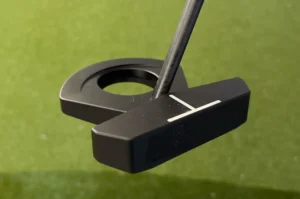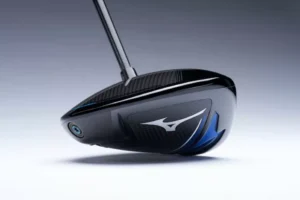The chip and run is a useful yet often underutilized shot that every golfer should have in their arsenal. This versatile shot allows you to get the ball onto the green and rolling towards the hole when there are no hazards between your ball and the pin.
Executed properly, the chip and run takes much of the precision required in finesse shots out of play and turns into a higher percentage shot. Even if you don’t make perfect contact, a chip and run will still get you reasonably close to the hole. Let’s deep dive into How to Hit a Chip & Run in Golf.
When to Use the Chip and Run
The chip and run works extremely well when the area around the green is closely mown and relatively flat. With no bunkers or water hazards to contend with, you can confidently land the ball on the fringe and allow it to release and roll out onto the putting surface.
The shot is especially useful when you have a good distance to the hole but the lie in the rough or fairway precludes a full iron shot. The chip and run allows you to bypass the trouble and get the ball rolling on the green.
This shot is also a great option when you are between yardage gaps with your wedges. For example, if you have 50 yards to the pin but your sand wedge carries 60 yards and gap wedge 40 yards, the chip and run split the difference nicely. The running release after landing cuts down on the total carry distance.
The chip and run is essentially a bump and run played from just off the green instead of the fairway.
Some key advantages of the chip and run:
- Requires less precise contact than a lob wedge chip. Even a fat or thin shot will get reasonable results.
- Controls distance well. The running component reduces variability in total distance.
- Avoids many common chipping mistakes. Less hand action lowers the chance of blade or chunk.
- Deals with tight lies in the fringe when a putter is unworkable.
- Great option when lots of green to work with between you and the hole.
How to Hit a Chip & Run in Golf – Proper Setup and Technique
The chip and run stroke is similar to other chip shots around the green. The major difference is your intent to land the ball into a closely mown area and allow it to release and roll out onto the green. Here are some keys:
Chipping Stance:
- Feet close together, shoulder-width or less. This promotes balanced rotation in the stroke.
- Weight favoring the front foot, knees flexed. This helps strike the ball first and then the turf.
- Ball position just inside front foot for most chips. Maintains descending strike for through impact.
Chipping Grip:
- Fingers together in a variant of the putting grip to de-hinge the wrists.
- Handle pressured more by the fingers/palm versus the palms based on chipping distance.
Club Selection:
- Pick a 7-8 iron for the chip and run. Less loft helps the ball stay low off the clubface.
- Moderate or low bounce. Bounce can cause the club to bounce off the turf rather than enter it.
- Avoid wedges with 56 degrees or more loft. These launch the ball too high with max backspin.
- Use the same club consistently to dial in distance control.
Backswing:
- Restrict the length of the backswing to about 3/4 of your full swing. Keeps shot simple with more focus on impact.
- Wider than a putting stroke but not big. Maintain connection to the ground.
- Let the shoulders turn to start the swing rather than the hands and arms.
Impact and Follow-Through:
- Make a descending blow to sweep the ball cleanly then compress the turf.
- Keep your head still with eyes focused just in front of the ball. Maintain spine angle.
- Allow the club to track low and left (for righties) along the turf after striking the ball.
- Follow through towards your target with chest facing the hole. Complete the stroke.
The key is making solid contact to cleanly get the ball airborne, then landing in the closely mown fringe and letting the ball release and roll out. Eliminate as much of the “hit” as possible and maintain smooth acceleration through impact.
Distance control comes from your landing zone. The closer to the hole you land it, the less roll-out distance will occur. If you need max distance, land the ball further back on the run-up to the green.
Executing the Chip and Run
Success with the chip and run comes down to consistently solid contact and an understanding of your landing zone in relation to the hole location.
Landing Zone:
- For max distance, land the ball up to 2/3 of the way to the hole.
- For a stock shot, land the ball about halfway to the hole.
- For less rollout, land the ball only 1/4 of the distance to the hole.
You can fine tune your landing spot based on factors like green firmness, temperature, or if you are chipping into or downslope. But in general, pick a landing zone halfway between you and the pin and practice sticking to it.
Distance Control:
- Use club selection to control how far the ball rolls out after landing.
- Higher lofted clubs like an 8-iron will land softer and release less. Good when you’re closer to the green.
- Harder, lower-lofted clubs increase rollout after impact. Use when further back in fringe.
- Choking down shortens the leverage and decreases distance for finesse.
Troubleshooting Fat and Thin Shots
Flubbing the chip and run can still produce decent results, but avoiding bladed or chunked shots is ideal. If you struggle with consistency:
- Focus on making clean contact and compressing the turf through impact. Don’t help the ball into the air.
- Ensure your body strikes a balanced finish position after contacting the ball. Don’t sway.
- Check that your ball position is just inside your front foot with handle leaning forward.
- Accelerate the clubhead smoothly. Slowing down or decelerating hurts solidness.
Practice and experience will teach you how far the ball rolls out with different clubs from various landing zones. As you dial in your distances, the chip and run becomes an extremely useful shot to keep in your arsenal.
When Not to Use the Chip and Run
While versatile and effective in many situations, the chip and run is not a cure-all around the green. Be cautious in these situations:
Severe Downhill Slope
The chip and run depends on controlled release and roll after landing. On a steep downhill, you can’t regulate the ground rollout as the ball will race away from you.
Lots of Break on the Green
With big undulations or tiers on the green, landing the ball short and relying on rollout could take it way offline from your target. A lofted chip may be better to land closer to the hole location.
Tight Lies in Fringe
Soft, gnarly fringe grass can cause the club to bounce rather than smoothly sweep the ball. When lies are iffy, use a more vertical-striking lofted wedge.
When Precision is Needed
If you need to fly the ball onto a front pin placement surrounded by trouble, utilize a lob wedge or another chipping technique.
Identify when factors or trouble surrounding the green demand more precision than the chip and run allows.
Practice Drills and Training Aids
Improving your chip and run requires practice to ingrain proper technique and distance control. Here are some helpful ways to work on it:
Technique Drills
- Hit chips focusing on solid contact, compressing the turf through impact. Don’t worry about outcome, just the feeling of sweeping the ball off the turf.
- Work on landing zone consistency. Pick targets at varying distances and dial in landing the ball in a precise zone every time. Groove swing adjustments to control the landing spot.
Training Aids
- Use impact tape on the clubface to ensure you are making crisp contact at the moment of truth. Lots of tape left on the face suggests poor contact.
- Swing through impact nets to develop a sense of cleanly brushing the ball off the turf then sweeping the remaining grass. Learn the feel of compressing the ground after contact.
- Chip into chipping targets focused on precision landing spots to develop your distance control. Make it a game of trying to stick every shot within the target area.
Key Takeaways from Mastering the Chip and Run
Hopefully this overview gives you more confidence to use the chip and run to your advantage. Key points to remember:
- Versatile shot useful with no hazards in front of green and good lies to work with. Let the ground help the ball get to the hole.
- Maintain chipping technique but use less loft on the club to reduce air time and increase rollout. A 7 or 8-iron works well.
- Control distance based on your selected landing zone in relation to the pin. Forward for less rollout, backward for max distance.
- Simple concept of landing on closely mown fringe and letting the ball trickle and roll onto the green.








